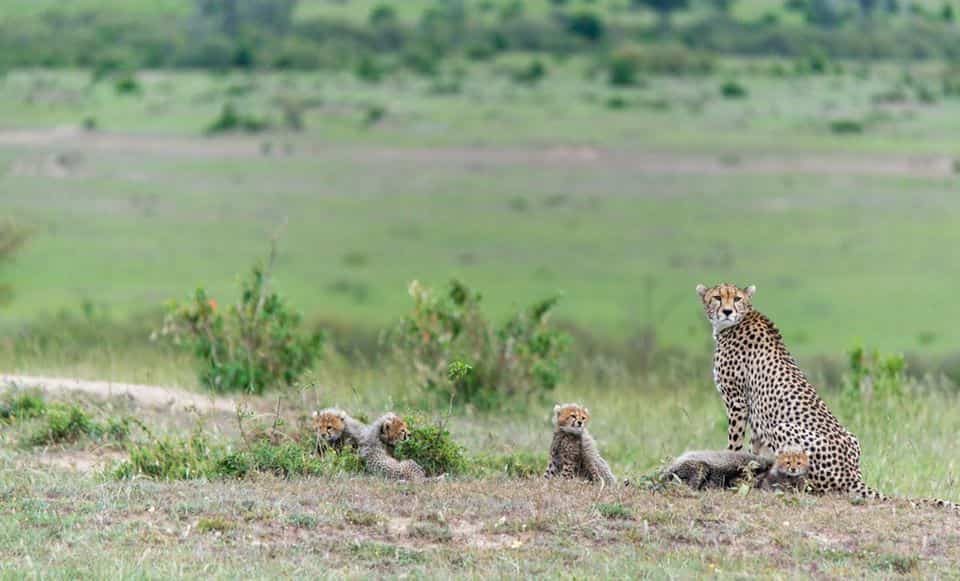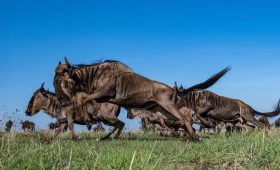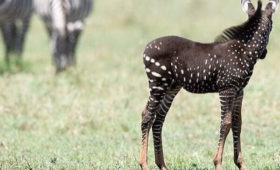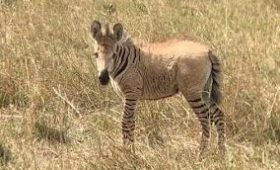Cheetah gives birth to seven cubs, yes you read that right, seven healthy bouncing cubs in the world most reknown reserve, Masai Mara. Now `Siligi` is a Maa Language Meaning Hope, and we are hope that the seven cubs are going to survive. Cheetah gives birth to seven cubs was in every tourist mind, wanting to have a glipse. However according to research and stastistics cubs rarely survive because of the harsh habitats, threat from lionesses and hynas feasting on the beutiful cubs. We believe & hope Siligi will be able to take care of the cubs despite the impending challenges. Cheetah gives birth to seven cubs in Masai Mara. Masai Mara never gets boring, just the other day we had rare breed of Zebra

Siligi figuring out how she will feed her cubs
Cheetah gives birth to seven cubs
Cheetah gives birth to seven cubs. The cubs have already escaped the clutches of a lioness. In the wild cheetahs usually give birth to three to five young, and they are vulnerable to predators from birth, so to see seven siblings together is very unusual.
In the wild cheetahs usually give birth to three to five young, and they are vulnerable to predators from birth, so to see seven siblings together is very unusual.
The adorable little cheetahs were spotted close to the Enkewa Camp in the Maasai Mara.

Cheetah gives birth to seven cubs
‘Only about 10 per cent of cheetah cubs reach maturity, so to see seven cubs at once from one litter is rare.
‘This mother, whose name is Siligi meaning hope, will hopefully see these cuties to adulthood.
‘She’s unfortunately in the Mara, where she’ll experience a lot of pressure from cars, as well as other predators.
‘But cheetahs in Mara also have help from The Mara Meru Cheetah Project where researchers working with Dr Elena Chelysheva will often stand watch over young cubs in their research vehicles, ensuring that tourist vehicles keep proper distance away. Cheetah gives birth to seven cubs, is a phrase that will linger in our tongues for a long time.
Some of the reasons we are afraid, raising the seven cubs might be a challenge.
The Cheetah above all else is the most reproductive cat. Why then is it so endangered? The answer is two-fold. Cheetah cubs often fall prey to Lions, Jackals, Birds of Prey, and Hyenas, as the mother must leave them behind while hunting for food. Even if the mother was near, she could not fend off an animal as large as a Lion or Hyena, the Cheetah was built for running not fighting. 90% of Cheetahs born die with in the first 3 months, 50% of which are destroyed by predators. The other 40% fall victim to lack of genetic diversity. This is the second reason for their inability to survive. This genetic peril is responsible for weak and underdeveloped immune systems. Disease and illness attack a weak immune system, which in turn causes death. Most cubs do not even make it past 1 month old when this is the case.
The Male cheetah is a deadbeat
After a gestation period of 90-95 days a female Cheetah will give birth to a litter of 3-5 cubs. The largest litter recorded in captivity was 8. The male Cheetah does not participate in the rearing of the cubs. The mother may leave the cubs for as long as 48 hours in order to hunt for enough food to sustain her in a lactating state. If the food supply is too scarce the mother may abandon the cubs, so as to maintain her way of life. Also if the litter is lost with in the first few weeks the female will come into estrus in the next few days. If this is not the case the mother will return and move the cubs from one location to another to better hide the smell of her young from predators. Sometimes the mother will even wait until night falls to return to her cubs, so that she is not as easily followed.
The cubs
The cubs are usually weaned at 6-8 weeks and will then leave the den and follow the mother from then on. If a young cub loses its original family, due to some great misfortune, it will find another family and join them despite the ill will from the new mother and being out cast by the new brothers and sisters. At 5 months old, the cubs are playing with one another, sharpening their stalking, chasing, and wrestling skills in a playful manner. At 6 months the mother Cheetah will fetch live prey injuring it and then giving it to the cubs so they may practice the art of the kill. At 8 months the cubs are chasing inappropriately large prey such as Giraffes. A Cheetah will not be a very skilled and efficient hunter until about 3 years of age. Cheetah cubs kill less than 10% of the prey, which the family feeds on. At 15-24 months the cubs will leave the mother, but may stay together for several more months. Young females will leave her brothers when they reach sexual maturity. Young males will travel far from parents and will lay claim to a territory as large as 300-800 square miles. Young females will stay closer to home and may even overlap territory with the mother.
The Social Life of a Cheetah
Female Cheetahs are solitary animals except when rearing a litter. Mothers with cubs will usually stay with in close proximity of one another. Females only come in contact with other Cheetahs in order to mate.
Males on the other hand will sometimes form coalitions of 2-3 in order to defend more land. These coalitions are mostly formed between brothers, but sometimes include outsiders for example the Tano Bora in Masai Mara. 30 % of coalitions are unrelated. Males are not territorial towards each other, but are in fact towards other males or coalitions. Due to coalitions fighting against one another the ratio has dropped to one male for every two females.
Hunting
The Cheetah is the fastest land animal, reaching a top speed of 70 mph! The Cheetah however can only run for short sprints of up to 300 yards. These sprints will usually last for 20 seconds, but rarely ever reach a full minute. Non-retractable claws and tough pads on their feet closely resemble that of a dog. These features offer better traction to get to those high speeds. A long heavy tail acts as a rudder for making those sharp turns while in pursuit. The Cheetah’s long fluid body is set over extremely light bones, this accompanied with large nasal passages, and oversized lungs, liver, heart and adrenals enable rapid physical response. This response is imperative to accommodate the Cheetah’s way of hunting. A strong spring-like spine gives added reach to the Cheetah’s long legs. A stride is the measured distance between successive imprints of the same paw. With the added reach given by the spine 1 stride can stretch as far as 7-8 meters. The Cheetah averages 4 strides per second or 1 stride per .28 seconds as the horse averages 1 stride per .44 seconds and can reach top speeds of 43 mph. The Cheetah can out run the horse going from 0-45 mph in 2 seconds flat, though this will not very last very long. The horse would inevitably win in the long run.
Cheetahs are equipped with several special features that are crucial in successful and efficient hunting. Binocular vision is a very important asset since Cheetahs rely on sight to hunt as opposed to scent. The retinal fovea of the eye is of an elongated shape, giving a sharp wide-angle view. This aspect of the eye is also adapted for speed. The dark “tear marks” on the Cheetahs face reduce glare from the bright sun also and aid in excellent vision. The Cheetahs will perch upon a fallen tree or rocky ledge to scope out the surroundings and potential prey. The Cheetah is also a very vocal animal. With the ability to mimic the calls of some birds, by displaying a high pitched chirping sound. When a bird falls for this deceiving call it will also fall prey to the sly Cheetah.
The Cheetah is a carnivorous animal and a diurnal hunter, which means it hunts during the day usually early morning and late afternoon. Cheetahs are solitary hunters except when living in a coalition. When this is the case they will hunt in groups so that they can take down larger prey. Unlike the common misconception, the Cheetah will pick out animals that have strayed from the herd as a target, not necessarily the weak or old. After chasing down and catching the prey, the Cheetah suffocates larger animals with a bite to the jugular and holding for as long as 15-25 minutes. Smaller animals are killed with a quick bite to the head usually killing them instantly. By this time the Cheetah is so tired from the chase that it must wait for as long as a half hour before consuming its meal, and could not fend off other predators, who might want to steal the Cheetah’s dinner. The Cheetah’s resting heart rate is approximately 120-170 beats per minute, while it’s heart rate after a chase is 200-250 beats per minute. The Cheetah’s resting breaths vary from 20-30 per minute depending on whether the Cheetah is in direct sunlight or in the shade, after a chase the Cheetah’s breaths per minute are 150-200! When done resting the Cheetah will quickly eat, as they can not defend their food from other predators for this reason they will not bury the food and come back for another meal. Half of the Cheetah’s hunts are successful, the other half are hard life lessons.








I simply couldn’t depart your website before suggesting that I actually njoyed the usual information an individual supply tto your visitors?
Is gonna be again craselessly in order to check up on new posts